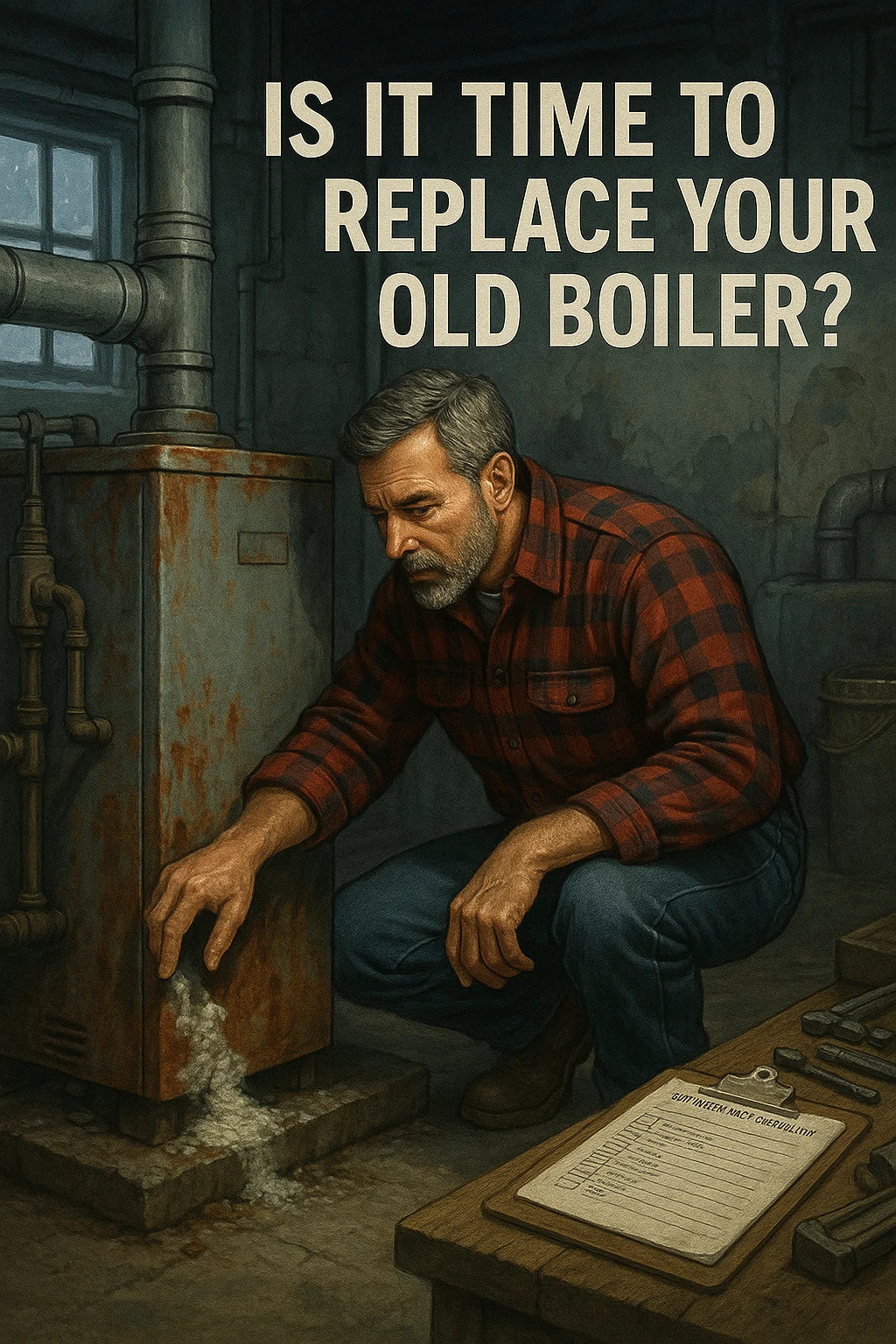For Mike Sanders—and any homeowner who’s experienced a cold night because the boiler died—knowing when to replace your heating system can save money, time, and stress. The last thing you want is a breakdown during a snowstorm when every HVAC company is booked solid.
So how do you know when your old boiler is beyond repair?
Here’s a straightforward, expert-backed guide to the warning signs, lifespan expectations, and cost comparisons that help you make the right call—before winter hits hard.
⏳ 1. How Long Should a Boiler Last?
| Boiler Type | Average Lifespan |
|---|---|
| Cast iron (like CGA-4) | 20–30 years |
| Steel sectional | 15–20 years |
| Condensing (high-eff.) | 12–15 years |
| Combi boilers | 10–15 years |
➡️ If your boiler is 20+ years old, you’re already pushing into replacement territory.
🔗 Energy.gov – Boiler System Basics
💸 2. Rising Heating Costs (Without a Cold Snap)
One of the biggest red flags Mike notices is the gas bill creeping up—without any change in outdoor temperatures or thermostat use.
Why It Happens:
-
Mineral scale reduces heat transfer
-
Inefficient combustion wastes fuel
-
Draft problems or burner misfires
Mike’s Tip:
Compare your gas bill this year vs. 3 years ago for the same winter month. A 15–25% increase likely points to system inefficiency.
🧊 3. Uneven Heating or Cold Zones
Do some rooms feel noticeably colder than others?
This can mean:
-
Circulator pump is failing
-
Zone valves are stuck
-
Boiler is short cycling and not sustaining full system heat
📍 If radiators/baseboards furthest from the boiler stay lukewarm, your system isn’t distributing heat properly.
➡️ Repeated issues = time to consider full replacement.
🔁 4. Short Cycling or Inconsistent Operation
Boiler turns on, runs for 1–3 minutes, then shuts off... and repeats.
That’s short cycling, which:
-
Wastes fuel
-
Increases wear on parts
-
Fails to heat evenly
Common Causes:
-
Oversized boiler
-
Failed thermostat or aquastat
-
Clogged heat exchanger
🛠️ Repairs can get pricey—especially if the heat exchanger is compromised.
💧 5. Rust, Leaks, or Mineral Buildup
If Mike spots any of the following during a visual inspection, it’s a big red flag:
-
Corrosion near the heat exchanger
-
White scale or rust around fittings
-
Dripping from pressure relief valve or expansion tank
-
Staining around base of boiler
📷 Take a picture and compare it year-over-year—deterioration means aging metal and eventual failure.
🔊 6. Strange Noises: Banging, Clanking, or Gurgling
Boilers should hum quietly.
If you’re hearing:
-
Kettling (like a tea kettle): scale buildup in heat exchanger
-
Banging or thumping: air trapped in pipes or sludge buildup
-
Gurgling: failing circulator or low water pressure
➡️ Repeated noise issues are more than annoying—they’re a symptom of deeper system wear.
⚠️ 7. Frequent Repairs Are Adding Up
If Mike finds himself calling the boiler tech every few months, it’s time to run the math.
Boiler Repair vs. Replacement Cost:
| Type of Service | Avg. Cost (2025) |
| Circulator pump | $400–$800 |
| Expansion tank | $250–$400 |
| Gas valve | $500–$900 |
| Heat exchanger (if repairable) | $1,200–$2,000 |
| New CGA-4 Installation | $4,000–$6,500 |
📉 If you’ve spent $1,500+ in the past 2 years and still have performance issues, it’s likely more economical to replace.
🔥 8. Outdated or Unsafe Venting
Older boilers may be venting into oversized masonry chimneys without liners.
That can cause:
-
Flue gas condensation (acidic damage)
-
CO backdrafting risks
-
Draft failure in cold weather
📋 IRC and NFPA codes now require chimney liners for most gas appliances (like the CGA-4).
➡️ Replacing your boiler also updates your venting for safety and code compliance.
🧊 9. Winter Breakdown Risk Factors
Mike lives in a cold climate—meaning a failed boiler in January isn’t just inconvenient, it’s dangerous.
📋 If your boiler:
-
Is 20+ years old
-
Shows signs of rust or leaking
-
Cycles short or loudly
-
Struggles to heat zones evenly
...you’re in the high-risk category for emergency winter failure.
🧯 Always have:
-
Backup space heaters
-
Pipe insulation
-
24/7 HVAC contact saved in your phone
✅ Conclusion: Mike’s Checklist—Time to Replace?
| Sign | Replace Boiler? |
| 20+ years old | ✅ |
| Rust, stains, or scale | ✅ |
| Cold rooms persistently | ✅ |
| Repairs exceeding $1,500 | ✅ |
| Carbon monoxide detector tripped | ✅ |
If you’ve checked 3 or more of these boxes, it’s time to get quotes on a replacement—like the Weil-McLain CGA-4 Series 3.
It’s better to schedule a planned installation now than deal with emergency prices and shivering in January.
🛠️ Mike Sanders’ takeaway: Be proactive, not reactive—and your boiler won’t leave you cold when you need it most.
In the next topic we will know more about: Switching to Natural Gas: What You Need to Know Before Replacing an Oil Boiler







